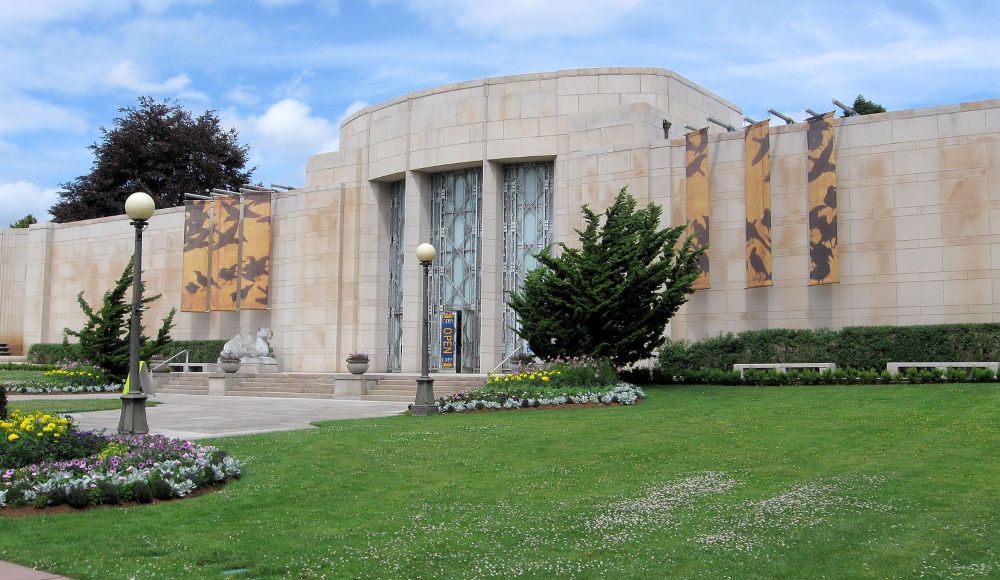Seattle architect Carl F. Gould was described by a rival as “an artistically gifted architect with extensive archeological and historical knowledge.” His handsome legacies are all around the city.

Gould’s roots grew from the Phillips Exeter Academy, Harvard, and the prestigious Ecole des Beaux Arts in Paris, France. Each of these institutions contributed to the character and talent of a man who would design some of the Pacific Northwest’s most original and revered buildings.
After completing his formal training before the turn of the century, he practiced architecture in New York with the well-known firm of McKim Meade & White, taking a hand in the terra cotta ornamentation of the old Pennsylvania Station, the Brooklyn Museum of Art, and private homes of New York’s wealthy residents.
In 1914, Gould joined Charles H. Bebb of Seattle to form Bebb & Gould. Beginning with the G.W. Fischer building on Seattle’s Third Avenue, the partnership moved on to create the Times Square Building, still one of Seattle’s stately neo-classical structures and festooned with a terra cotta finish. Gould was also a principal designer of the Ballard Locks and many homes for Seattle’s newly-rich. Art Deco later featured in Bebb & Gould designs reflected in the gleaming Seattle Art Museum in Volunteer Park, a breakthrough in modernist design for museums, and at the University of Washington’s sturdy Henry Art Gallery.
Gould, who was described by a Phillips Exeter teacher as “very gentlemanly,” earned a modest C-point average, was non-athletic, and spent time tinkering with photography. In time, he would find his calling in the study of history and art at the Ecole des Beaux Arts in Paris. From that time forward his work showed affection for the classical past and opened his mind to new ideas.
He developed a civic spirit. Joining the new Seattle Municipal League, he fought for a city plan that was opposed by influential property owners. Never mind his reputation as a “gentleman architect,”he entered city-wide frays related to public art and architecture. For example, one tiny monument from his hand is Prefontaine Park and Pool at the historic downtown corner of Third Avenue and Yesler. Overcoming an earlier gaudy design which had been approved by Father F.X. Prefontaine before his death, Gould laid out a simple haven with a blue-tiled fountain and pool, topped off by playful sculptured turtles.
Another controversy arose when Gould took a verbal poke at Alonzo Victor Lewis’ statue, The Doughboy, a monument to the Great War. At first called “Bringing Home the Bacon,” and later “Armistice,” Lewis was proud of his subject’s fierce, smiling version of a soldier tramping home carrying souvenirs which had presumably been plucked from the bodies of dead Germans. Gould described the Doughboy’s peculiar smile as “bestial and animal.” the sculptor sued Gould for $50,000 damages. The suit was eventually dropped, but the controversy lingered for many years.
Gould’s talents are to be seen throughout Puget Sound country. T. William Booth and William H. Wilson summarized the life of Carl F. Gould in their 1995 book Carl F. Gould: A Life in Architecture and the Arts (UW Press). The authors provide detail about Gould and Bebb’s development of the University of Washington campus, including many of its finest buildings. Over 30 years of outstanding architectural work, mostly in the Puget Sound region, is described.
Today, his work and life are studied at Carl F. Gould Hall by architecture students at the University of Washington. Members of his family, such as daughter Anne Gould Hauberg, continued to make notable contributions to the arts and culture of our Far Corner.
Discover more from Post Alley
Subscribe to get the latest posts sent to your email.

Great piece! Now how about Sasaki, the architect of the IBM Building, Pacific Science Center, and the now destroyed World Trade Center buildings in NYC? He was a UW grad, a contemporary of Eddie Carlson and Warren Magnuson. Carlson insisted on his getting the commission for the Science Center. And Sasaki had an interesting (ultimately sad) life too.
Eric, I believe you are referring to the late Minuro Yamasaki.
https://www.architectural-review.com/essays/reputations/minoru-yamasaki-1912-1986
And Minuro Yamasaki was the architect of Rainier Square, where I worked in the late 80s. I loved that building beyond all reason (Still do). I sorely miss the Seattle of those days!